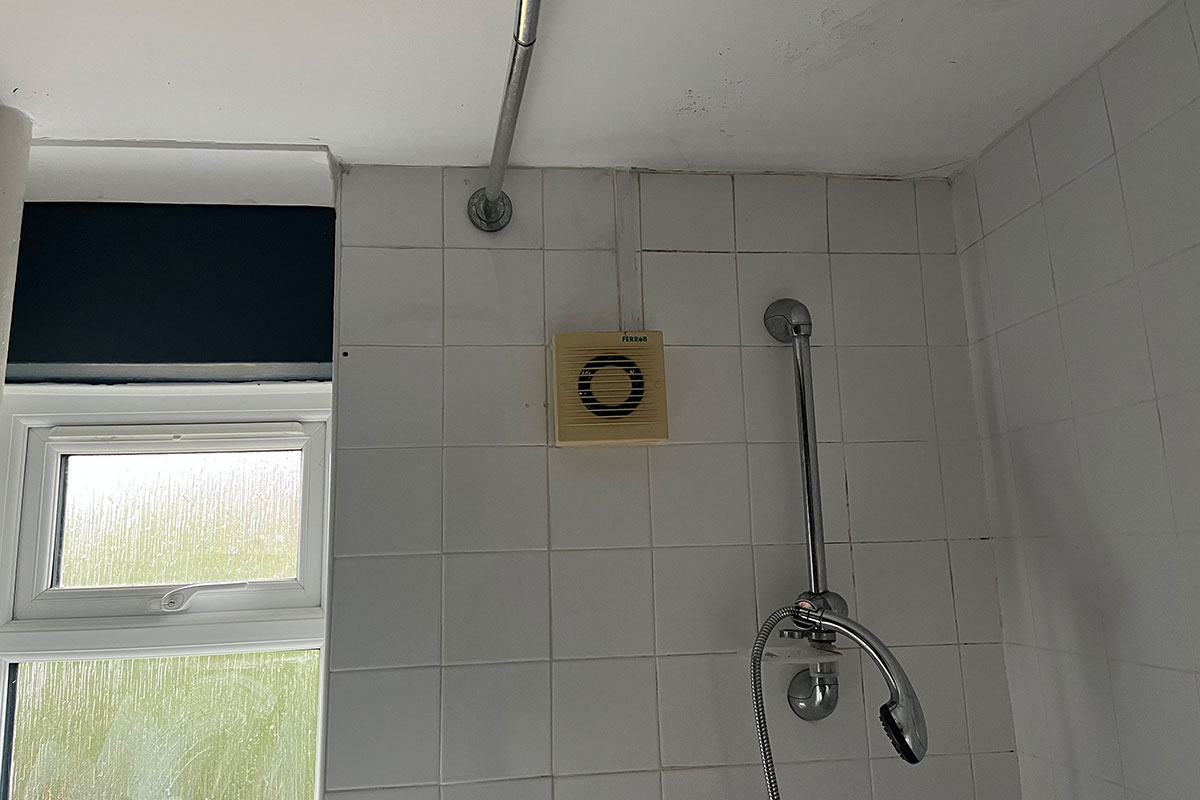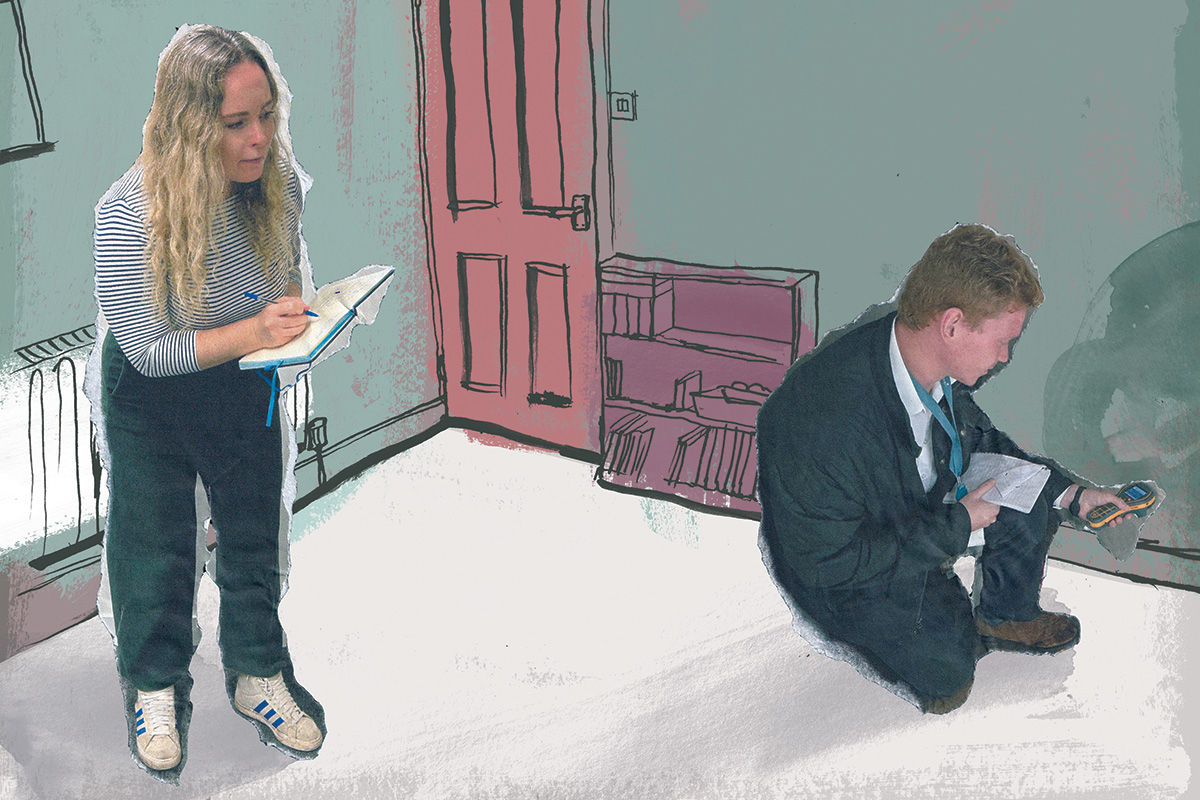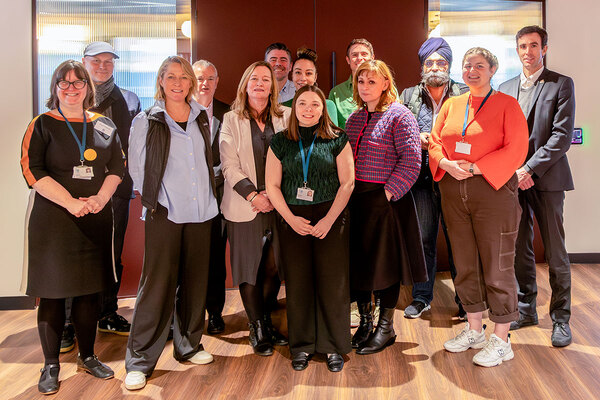One morning with a survey team trying to fix the damp and mould crisis
After the Housing Ombudsman told A2Dominion to review its repairs processes, the housing association turned around tenant satisfaction ratings in a matter of months. Grainne Cuffe spent a morning with a lead surveyor and two trainees to find out how. Illustration by Ben Tallon
“The industry was basically drunk dancing,” Sean Frizell says. “Everyone thinks they dance perfectly when they’re drunk. But when someone videos you and you play it back, you think, ‘I can’t dance.’”
Mr Frizell, a senior technical manager at A2Dominion, is referring to the state of the social housing sector just before the disrepair scandal hit. After a public inquest into the death of two-year-old Awaab Ishak from respiratory issues, the full extent of failure was exposed.
We are standing upstairs in a small terraced house in Sunbury-on-Thames in Surrey – it is being surveyed because it has recently become void, and Mr Frizell and two trainee surveyors are checking for water ingress.
A2Dominion – although certainly not alone – has been on a rocky road when it comes to damp and mould. In October last year, the Housing Ombudsman ordered the housing association to carry out an independent review of its response to leaks, damp and mould, following three severe maladministration findings dating back to 2017.
In July, the watchdog published a report on the resulting review. Richard Blakeway, the housing ombudsman, described it as a “frank, forensic and far-reaching assessment by the landlord to identify the root causes for repeated service failings”. “It is a powerful report which should be read by other landlords of all sizes who may be facing similar challenges handling repairs and complaints,” he said.
The review made 37 recommendations for improving its repair service, leasehold management, resident data and complaint-handling. But it is putting all that into practice which matters. Inside Housing has come to see what one crucial part of that looks like.
Since the review, A2Dominion – which manages more than 38,000 homes across London and the South of England – has grown its team of in-house surveyors from two to 11, and created a new team to support residents who need to move out of their homes while repairs are carried out. In the past two years, the association has reviewed more than 5,700 disrepair cases, and is introducing new recording systems to track repairs and maintenance work. Surveyors are told to check for damp and mould at every property visit, regardless of the reason for attendance – but if the survey is specifically for damp and mould, they are encouraged to spend up to an hour-and-a-half in a home. They look at the whole history of the property before entering, including previous surveys and repair logs.
A2Dominion has made changes to its “prioritisation policy”; the landlord no longer uses the term ‘vulnerable’ to categorise residents, following advice from tenants and local communities. It is also introducing case managers to be the first point of contact for residents.
In its first year of recording tenant satisfaction measures (TSMs), the landlord scored 57% for satisfaction with overall repairs service, on the low end of results. But since April 2024, it has increased that by an impressive 10 percentage points (and without altering its survey methods). The changes appear to be having an impact. So Inside Housing reached out to A2Dominion to see its approach first hand.
It is a dull, wet day in September when we arrive. Mr Frizell says these are “perfect” conditions for an inspection as the rain makes it much easier to spot damp problems or leaks while at the property.
We are joined by trainee surveyors Rachel King and Matthew Riley. The pair have worked in social housing for decades between them, but are looking for new roles within the organisation. Ms King, who joined A2Dominion in 2022, has worked in the housing sector for almost 12 years, primarily in housing management, but has an interest in surveying that came from being in and out of residents’ homes in her previous work – and through doing her own DIY. “So when the opportunity came up, I leapt at the chance,” she says.
Does having a background in housing management give her useful experience to bring to the new role? “Yes, I can really engage with residents and understand. I’ve done a lot on mental health and safeguarding, as well as building that tenant relationship,” she reflects. “When you do come out to survey a property or whatever you’re there for, it’s not necessarily just looking at that issue within the property. If there are other things going on that are impacting our customers, then you want to be looking at that as well and going back, either raising safeguarding or talking to relevant departments.”
Mr Riley has worked for A2Dominion for seven years, first in customer service, then the gas department. “I just wanted to be a part of the solution to the problems tenants were facing,” he explains. “I wanted to get out and about and meet them, rather than hearing about it on the phone or in engineers’ reports. I’ve also always been interested in construction and wanted to get the technical skills to be able to help our customers.”
The housing association launched an in-house training programme to create some “homegrown” surveyors in response to a shortage across the sector.
11
In-house surveyors at A2Dominion, increased from two
38,000
Homes managed by A2Dominion
Mr Frizell says that as the trainees spend a lot of time with different surveyors, they pick up “all the good traits” and a huge wealth of experience held by older members of the team, passing on the institution’s memory at this crucial time. The association currently has four trainees, but the scheme – which started in 2023 – will continue, training up new surveyors each year.
We start the survey outside. “Normally, we would start from the exterior to see if there are any visible defects that we can identify within the damp proof course or membrane, if there are any gutters overflowing, and this [weather] is the perfect condition for that kind of identification,” says Mr Frizell.
“If it hadn’t been raining, we would look for staining on the exterior to match up any ingress [inside]. We would also step back as far as we can to do a visual inspection of the roof externally to see if there are any broken tiles. A lot of penetrating damp is because of a defect in the roof or gutters.”
Mr Riley tells me the damp course and brickwork looks intact, but there are some cracks in the wall, so we will need to check for any potential ingress of water. He uses a high-tech damp meter to read the wall’s temperature, and exact levels of moisture and relative humidity. It has a sensor feature which means it can make a reading from a distance by pointing a laser at the wall. Mr Frizell says the accuracy of the meter “cannot be questioned” and “should be industry standard”. Some landlords, he says without naming names, are still using meters that just read “wet and dry”.
Treating the problem
As we move through the house, Mr Frizell explains the process if it was tenanted. “We would be engaging with the customer, asking generalised questions about how they use the property. There used to be a lot of talk in the old days about ‘lifestyle’ [since criticised by the Housing Ombudsman and coroner for Awaab’s inquest]. We use that in a positive way now. Everyone lives in their property differently, so we need to get a better understanding of how they live to help them adjust. Or they can carry on, but let them know if they do this, then it will alleviate the issue,” he says.
Residents are responding well, Mr Frizell says. If there was a problem with mould, the surveyor would recommend a mould wash and anti-mould paint, which stops fungal spores taking root and growing.
That treatment has been criticised by some social tenants, so is it effective? Mr Frizell knows very well as he tested it in his home before A2Dominion rolled it out.
“For a lot of our properties, [we] may not be able to put extraction units in. I tested this in my house because I can’t put an extractor fan in,” he says, adding that in conservation areas it might not be allowed by councils. “I’ve done tests in my bathroom, because I don’t have a fan or trickle vents, so it’s the perfect storm. I have kids that will not open a window and have showers forever, so humidity levels were increasing.”
The paint, he explains, is described as thermal insulation paint and was designed for hot countries to reflect heat from tin outbuildings to reduce the temperature and make it more bearable in factories.
“But it works perfectly [on the inside] because any heat bounces back into the property. It will not allow condensation to form,” he says.

We move into the kitchen. Everything passes tests except for the kitchen extractor fan, which is old and manual, and needs replacing. “It needs to be upgraded to one that kicks in at 65% humidity, so they don’t have to keep switching it on and off,” Mr Riley explains.
Next they check the boiler, look under the sink to check for leaks past and present, stains in the paint work, and the floor for signs of damp. In the sitting room, the former tenant has installed lights in the ceiling without permission, which will have to be removed.
In the bathroom, we find some mould on the ceiling. The extractor fan also needs to be upgraded and moved higher to capture any rising moisture. A mould wash and paint will be ordered.
Next we move into the bedrooms, which are clear of any issues, and the final stop is the loft. Mr Riley heads up into the roof space and finds that the insulation does not fully cover the underside of the roof. “There were also a few tears in the roof felt so we’ll have to get a roofing company out to repair that, as well as a specialist insulation contractor to ensure it’s laid to an adequate thickness and covering the entire space,” he says.
After this work is completed and the next resident moves in, housing managers will return in six months for a courtesy visit to see how everything is going.
Before finishing up, we discuss what it has been like in the sector since the major issues with damp and mould have come to light. Mr Frizell uses his “drunk dancing” metaphor as we talk about responsibility.
“You can’t just fix a window when there is mould on the wall,” he says. “Every time someone goes into a property, they are taking a holistic approach, checking for, and capturing, everything. If we find that a [member of staff] has been in and out of a property, they will be held accountable. They’ve let that person live in that condition, because they haven’t reported it back to us.”
I ask how often staff fail to report a problem when they must have witnessed it. It happens, he admits, but in “small numbers”. “We want to nip that in the bud.”
Staff are also regularly reminded about safeguarding. He says: “A broken door with a hole in it – that could be a sign of domestic violence. All of our staff are trained up to be able to spot those kinds of signs, so as soon as we see a slight risk, we address it.”
Mr Frizell describes the death of Awaab Ishak as a moment of realisation for A2Dominion, and for the whole sector. “We looked at ourselves and thought, ‘We’re not doing the best we can here,’” he says. “Where can we improve? And that’s why we’ve bolstered all our teams, we looked at the structures and the best way to serve our company… so we no longer ‘drunk dance’.”
Recent longform articles by Grainne Cuffe
The first year of tenant satisfaction measures: the results
Government overhauled consumer regulation following Grenfell. Now, an Inside Housing survey of more than 200 councils and housing associations reveals the first results from the new TSMs regime. Grainne Cuffe investigates
Awaab’s Law: how it could challenge and change the sector
The consultation is out for Awaab’s Law, setting time limits for English social landlords on responding to repairs that pose a hazard to tenants. But what exactly is in the proposals? Grainne Cuffe reports
Homeless and on hold: the battle to get support from councils
Being threatened with homelessness is stressful enough. But, in some council areas, the process of getting support from the council is making things harder. Grainne Cuffe reports
Housing officers under pressure
Grainne Cuffe talks to housing officers about the stress of their jobs, as Inside Housing reveals that turnover in some frontline roles has risen dramatically











